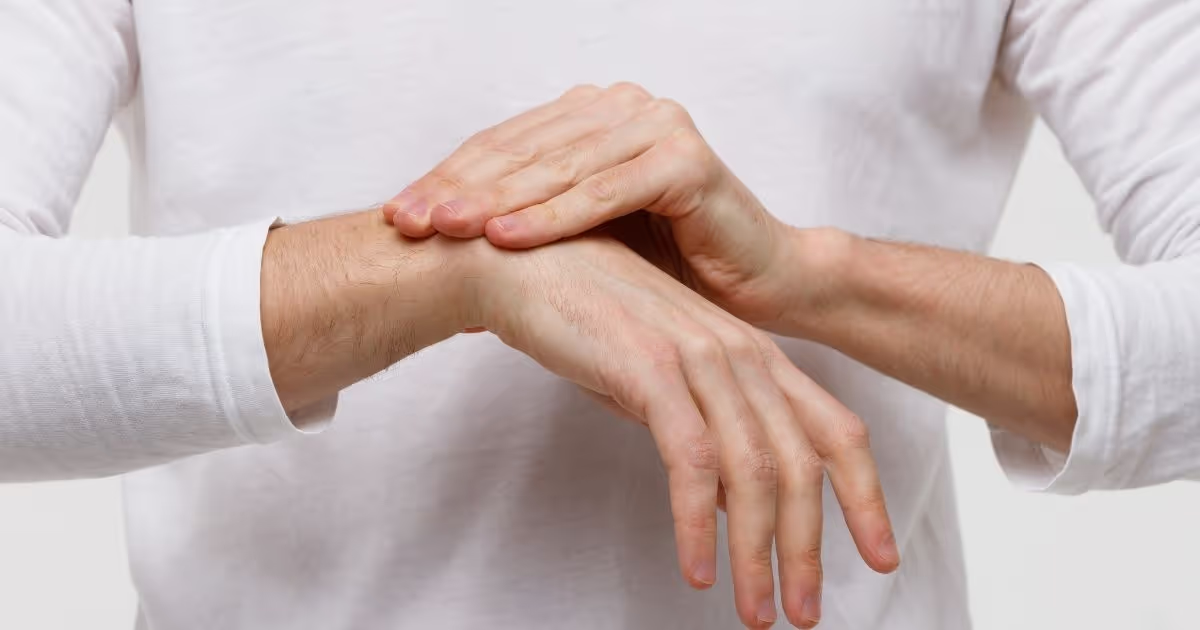Choose the content to read
Carpal Tunnel Syndrome
Carpal tunnel syndrome is when there is pressure on the median nerve as it travels through the carpal tunnel. The carpal tunnel is a narrow passageway located in the wrist and formed by bones and ligaments.
Several factors may contribute to carpal tunnel syndrome, including the wrist anatomy, health conditions, and using specific hand motions repeatedly.
Signs and symptoms
The signs and symptoms of carpal tunnel syndrome will most likely include tingling or numbness or a feeling of electric shock in your fingers or hands. It often occurs on the thumb, the index finger, the middle finger, or the ring finger but not the little finger. These symptoms usually occur during daily routines, such as driving or holding objects like phones or newspapers. It may also wake you up at night and you may notice the numb feeling in the morning. The feeling of numbness may evolve over time. A feeling of numbness may occur, which results in the feeling of weakness in your hand and leads to the dropping of objects. In severe cases, there may be a sign of a wasting of thumb muscles.
When to consult your doctor
You should seek medical attention if these symptoms cause a disturbance in your daily routine and sleep patterns. If left without treatment, it could result in damage to the permanent nerve and muscle.
Causes
The median nerve is the main nerve that enables us to move muscles around our thumbs. It also gives the sensation to the area in your palm from the thumb to your middle and ring fingers, excluding the little finger. Any irritation or compression to the median nerve will most likely cause carpal tunnel syndrome. The thickening of the ligament over the median nerve is the leading cause of carpal tunnel syndrome. Other reasons are wrist fractures and rheumatoid arthritis, which can cause swelling and inflammation. However, there is often no specific cause of this condition, as it could combine many factors that contribute to carpal tunnel syndrome.
Risk factors
Several risk factors could be associated with the condition. These factors may not directly be the cause of carpal tunnel syndrome but may trigger irritation to the median nerve.
- Anatomic factors occur when there is a wrist fracture, a dislocation, or arthritis that causes wrist bone deformation and can create pressure on the median nerve. Those with smaller-sized carpal tunnels have a higher risk of developing this condition.
- Being women, as the carpal tunnel area of women is smaller than men, so it is more commonly occurring in women compared to men. Carpal tunnels of women who have developed this condition may have been even smaller than women who do not have the condition.
- Health conditions that damage the nerves, for example, those with diabetes will have an increased risk of nerve damage, which could lead to median nerve damage.
- Inflammatory conditions like rheumatoid arthritis can affect the linings around your wrist tendon, which could irritate the median nerve.
- According to some studies, there is a connection between carpal tunnel syndrome and some medications, like anastrozole (Arimidex), that are used for breast cancer treatment.
- Obesity is one of the factors that can develop carpal tunnel syndrome.
- Changes in fluid retention may irritate the median nerve and put pressure on your carpal tunnel. The condition is more common during pregnancy and menopause. Carpal tunnel syndrome is often associated with pregnancy but will eventually recover on its own after pregnancy.
- Other medical conditions, such as menopause, thyroid disorders, kidney failure, and lymphedema, could lead to a higher risk of developing carpal tunnel syndrome.
- Workplace factors that require repetitive wrist flexion will put pressure on the median nerve, such as working with tools or on an assembly line. These types of working conditions could harm or worsen the damage in the carpal tunnel and could worsen in a cold environment.
According to researchers, there is some association between working on computers and the development of carpal tunnel syndrome. Some evidence even states that it could be the use of a mouse as opposed to the use of a keyboard. However, there is inadequate evidence that will support how repetitive computer use can be directly associated with carpal tunnel syndrome.
Diagnosis
Your doctor may ask you about your symptoms’ pattern, such as the specific finger that the sensation occurs in. If you have a symptom in the little finger, for example, you may have other conditions than carpal tunnel syndrome. Your doctor will also give you a physical examination by testing your hand muscles and the feeling of your fingers. Bending the wrist, tapping, or pressing on nerves can sometimes trigger the symptoms. Sometimes an X-ray is recommended to determine arthritis or fracture. Your doctor sometimes advises you to take an electromyography test, where he or she will insert an electrode needle into specific muscle areas. It will help assess how your muscles contract and rest with electrical activity. This test can help determine if there are any median nerve muscle damages. Another type of electromyography is the nerve conduction study, where you will be taped with two electrodes that will help determine if there is a slowdown of electrical impulses in the carpal tunnel. The test can also help to determine the carpal tunnel syndrome condition.
Treatment
There are some simple self-care treatments at the early stage of carpal tunnel syndrome that you can do, such as taking more breaks to rest your hands, avoiding any activities that could worsen your symptoms, and using cold packs to reduce swelling.
Optional treatment options include wrist splinting, medications, and surgery. Conservative treatments such as wrist splinting can help with mild to moderate symptoms within the period of less than 10 months. You need to seek medical treatment if you experience numbness in your hands.
These nonsurgical therapy methods may help with the treatment in the early stage of carpal tunnel syndrome:
- Wrist splinting is a method in which you hold your wrist in a still position when you sleep to relieve tingling and numbness at night. Nighttime splinting might be an alternative option for those who are pregnant, as it does not involve the use of any medications. Nighttime splinting can also help prevent symptoms during the daytime.
- The use of nonsteroidal anti-inflammatory drugs (NSAIDs) such as ibuprofen (Advil, Motrin IB, for example) may help relieve the short-term pain from carpal tunnel syndrome.
- Your doctor may use cortisone or an injection with corticosteroids to inject your carpal tunnel. An ultrasound will sometimes be used to guide these injections.
Corticosteroids help relieve pressure on the median nerve, so your pain will be subsided. It works by decreasing symptoms of inflammation and swelling. Corticosteroid injections are more effective than oral corticosteroids for the treatment of carpal tunnel syndrome.
There is also evidence that treating arthritis may reduce symptoms of carpal tunnel syndrome that is caused by rheumatoid arthritis or other inflammatory arthritis. But there has not yet been enough supporting evidence for it.
Surgery may be advised by your doctor based on the severity of your symptoms or the unresponsiveness to other treatments. Carpal tunnel surgery helps to relieve pressure by performing a cut of the ligament that puts pressure on the median nerve.
There are two different surgical techniques, which are endoscopic surgery and open surgery. For endoscopic surgery, your surgeon will use a scope device attached with a camera to examine the inside of the carpal tunnel. The surgeon may perform one or two small cuts of ligament on your hand or your wrist. Sometimes an ultrasound is used instead of a telescope to help guide the tool that is used to cut the ligament. The other surgery technique is an open surgery when your surgeon makes an incision in the ligament to free the nerve within the carpal tunnel area located in the palm of your hand.



























